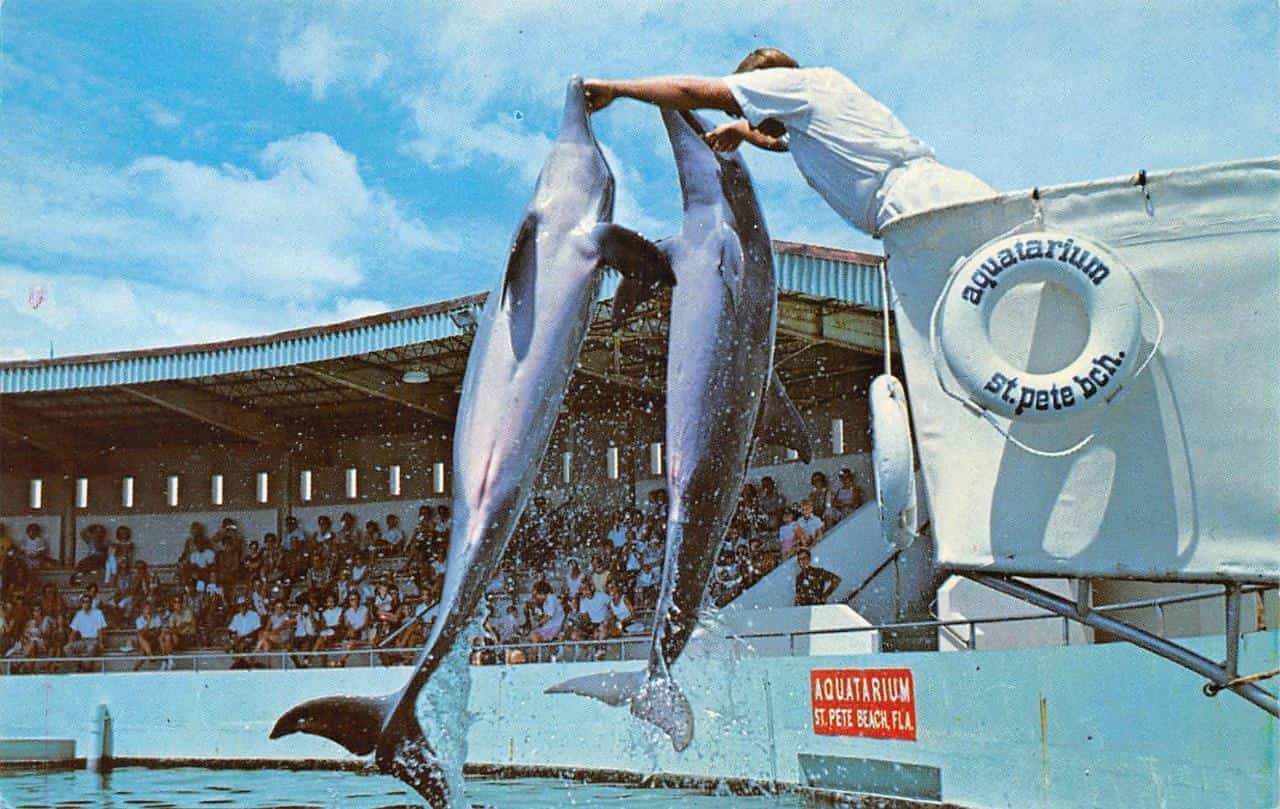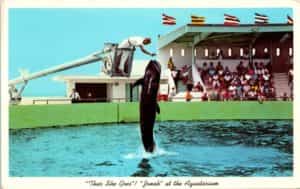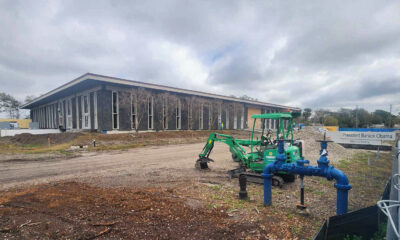Create
Vintage St. Pete: The Aquatarium

Jonah the whale never had a chance.
A 2,000 pound pilot whale, Jonah was the “star attraction” at the Aquatarium, the $3.5 million marine park that opened on St. Petersburg Beach in the summer of 1964. Flipper, a series of hit family movies, would soon be all the rage as a Saturday night TV series, and tourists would surely pay good money to see bottlenose dolphins leaping through hoops, tossing beach balls and towing little dogs around on little surfboards. Why not a whale?
Jonah, 16 feet from snout to tail, was netted by a Palos Verdes Marineland crew and sold to the fledgling park across the continent. For two years, the Pacific short-finned pilot whale – a deep-water species not made for swimming in endless circles inside a circular tank 26 feet deep – rocketed out of the water on command, snatching a frozen smelt from the outstretched hand of an employee. That was her “trick,” and she did it a dozen times a day.

Jonah and friend
Animal husbandry, of course, was not exactly fine-tuned in 1964, and in the spring of 1966 Jonah the whale stopped leaping, and stopped eating, and almost exactly two years after the Aquatarium debuted, she rolled over and died. Jonah was not replaced, and the Aquatarium’s dolphins and sea lions continued to captivate record crowds. Her name was not uttered again.
The argument over the captivity of marine mammals, and making them do unnatural things for gawking crowds, has gone on for more than half a century, and will doubtless continue. Pilot whales are no longer kept in tanks for the amusement of tourists; Sea World’s treatment of orcas (aka killer whales) has come under intense scrutiny and criticism over the past decade.
Political correctness – not to mention moral responsibility – was not on anyone’s mind when the Aquatarium opened its doors, on 17 acres right on the beach between 64th and 66th Avenues, on June 27, 1964. The park was developed and bankrolled by South Florida businessman L.G. Ball, owner of the profitable Miami Seaquarium (not coincidentally, home of the very animals used for Flipper).
A circus atmosphere prevailed, with band music blaring out of the loud speakers, and Aquatarium officials all “spit and polish” in their green uniform coats and gold trousers. There were two shows for customers to see – the feeding of the porpoises and Jonah the whale in the big tank, and performances by the sea lions and porpoises in the smaller tank.
St. Petersburg Times
June 28, 1964
RELATED STORY: VINTAGE ST. PETE: Paddy the Porpoise and the Marine Arena
 RELATED STORY: Winter’s legacy: Respect for the bottlenose dolphin
RELATED STORY: Winter’s legacy: Respect for the bottlenose dolphin
At 1.2 million gallons, the “big tank” was billed as the largest in the world. Over the smaller, a gold geodesic dome rose 160 feet into the St. Pete Beach skyline, making the Aquatarium one of the area’s most instantly-recognizable landmarks, along with the Sunshine Skyway Bridge and the Don CeSar hotel.
Sea water was pumped in from the adjacent Gulf, and filtered before it reached the big performance tanks.
Scores of local teens and young adults worked at the Aquatarium, from gift shop and maintenance jobs to diving, swimming and feeding the mammals and fish, and crewing the “collection boats” that netted new residents.
 Although there were small saltwater aquariums stocked with both indigenous and tropical fish, the emphasis was never on education. Most people just wanted to see the dolphins – over time, and thanks to Flipper, the incorrect designation “porpoises” fell out of common usage – leap and play and make those delightful squeaky noises.
Although there were small saltwater aquariums stocked with both indigenous and tropical fish, the emphasis was never on education. Most people just wanted to see the dolphins – over time, and thanks to Flipper, the incorrect designation “porpoises” fell out of common usage – leap and play and make those delightful squeaky noises.
After 88 episodes on NBC, Flipper was canceled in 1967. The following year, Ball sold the Aquatarium to local hotelier Frank Canova for $2 million.
The bloom, however, was off the rose. Walt Disney World arrived three years later, and wiped clean the entire face of Florida tourism. “Roadside attractions” that weren’t near the Interstate highways – or weren’t in Orlando – saw business fall off and eventually collapse altogether.
Canova tried everything. He added a zoological park, with lions and tigers and bears, and in 1975 – in the wake of Jaws and the arrival of Sea World in Orlando – changed the name of the park to Shark World.
Nothing worked.
Last month, a dispute with the city of St. Petersburg Beach about the construction of a water-slide ride adjacent to Shark World ended with a decision by its owners to close the struggling beachfront tourist attraction.
St Petersburg Times
Aug. 27, 1977
Today, there’s no trace of the Aquatarium – or Shark World – on St. Pete Beach. It’s the Silver Sands Beach and Racquet Club.
The Miami Seaquarium bought the dolphins and sea lions, but the sharks, sadly, weren’t so lucky. Like Jonah the whale, they were more or less superfluous to human requirements.
“I’m afraid we’re going to have to end up destroying them,” Shark World trainer Mike Haslett told the Times on closing day. “We can’t just turn them loose because they’re conditioned to eating out of human hands.
“They’re not aggressive – they are passive – but we don’t want to take the risk of turning them loose and ending up with mass attacks.”
This story appears in the book Vintage St. Pete: The Golden Age of Tourism – and More (St. Petersburg Press).








